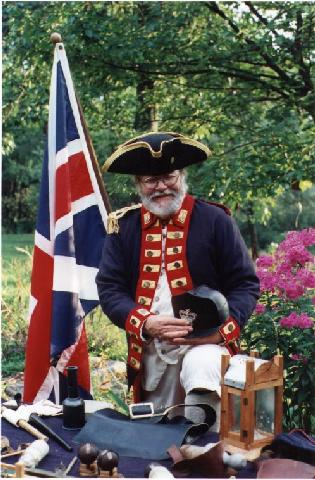THE HISTORY OF THE RECREATED ROYAL IRISH ARTILLERY
 In August of 1977 at the Maine Muster in Windham New Hampshire, Bill Knowles and Fred Lawson rolled out our first cannon and proceeded to "scare" the target. When the announcer asked who they were so he could inform the crowd, Fred answered "The Royal Irish Artillery". The only thing they knew at the time was that the unit did exist, and were in North America during the American Revolution. There were three cannons competing in that event, and the Royal Irish received the fourth place ribbon.
In August of 1977 at the Maine Muster in Windham New Hampshire, Bill Knowles and Fred Lawson rolled out our first cannon and proceeded to "scare" the target. When the announcer asked who they were so he could inform the crowd, Fred answered "The Royal Irish Artillery". The only thing they knew at the time was that the unit did exist, and were in North America during the American Revolution. There were three cannons competing in that event, and the Royal Irish received the fourth place ribbon.
Early research showed that some of the RIA might have been at Fort George in Castine, Maine during 1779, and in 1979, several of us were on the executive board to redo the "Penobscot Expedition." We decided then to recreate the unit formally.
Our second gun in was ready in 1982, and 1983 saw our first cannon trailer. Our Light Three Pounder, affectionately called the "Parade Gun" was the product of every Tuesday night from November 1984 to July 1985. During the same time period, members of our Northern Battery in Maine built our Howitzer. That summer in Damariscotta, Maine we fielded all four pieces; two guns for the King and two for the rebels. "We have met the enemy and they are us" became our war cry.
In the mid 1980’s, we started doing parades and events for local city and town organizations. We have performed the 1812 Overture with the Boston Pops, the Philadelphia Symphony Orchestra and the Boston Youth Symphony. The Royal Irish have even been part of a commercial for Maxwell House Coffees and an industrial film for the Ford Motor Company. Past 4th of Julys have seen the Royal Irish at Fort Independence, helping to fire the salute to the U.S.S. Constitution during her turn around cruise.
Over the years, we have gained new members, more knowledge, a large library and have had a lot of enjoyment doing so. Most importantly, we have gained a reputation as a safe and hard fighting unit. We are proud members of the British Brigade, and are constantly striving to better our interpretation and knowledge of our unit and the artillery of the 18th Century as a whole.






